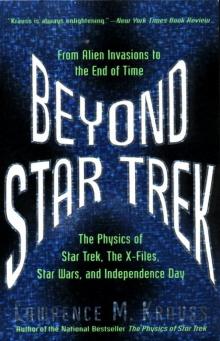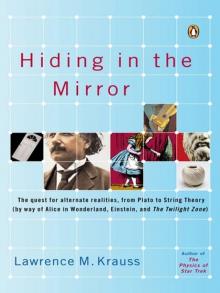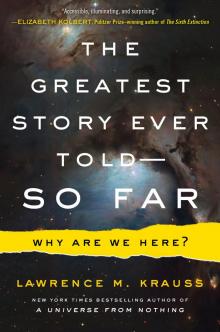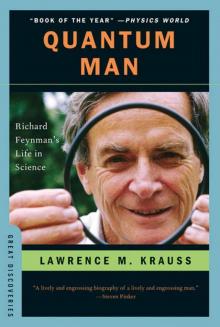- Home
- Lawrence M. Krauss
Quantum Man: Richard Feynman's Life in Science
Quantum Man: Richard Feynman's Life in Science Read online
PUBLISHED TITLES IN THE GREAT DISCOVERIES SERIES
Sherwin B. Nuland
The Doctors’ Plague: Germs, Childbed Fever,
and the Strange Story of Ignác Semmelweis
Michio Kaku
Einstein’s Cosmos: How Albert Einstein’s Vision Transformed
Our Understanding of Space and Time
Barbara Goldsmith
Obsessive Genius: The Inner World of Marie Curie
Rebecca Goldstein
Incompleteness: The Proof and Paradox of Kurt Gödel
Madison Smartt Bell
Lavoisier in Year One: The Birth of a New Science
in an Age of Revolution
George Johnson
Miss Leavitt’s Stars: The Untold Story of the Woman
Who Discovered How to Measure the Universe
David Leavitt
The Man Who Knew Too Much: Alan Turing
and the Invention of the Computer
William T. Vollmann
Uncentering the Earth: Copernicus
and The Revolutions of the Heavenly Spheres
David Quammen
The Reluctant Mr. Darwin: An Intimate Portrait of Charles Darwin and the Making of His Theory of Evolution
Richard Reeves
A Force of Nature: The Frontier Genius of Ernest Rutherford
Michael Lemonick
The Georgian Star: How William and Caroline Herschel
Revolutionized Our Understanding of the Cosmos
Dan Hofstadter
The Earth Moves: Galileo and the Roman Inquisition
ALSO BY LAWRENCE M. KRAUSS
Hiding in the Mirror
Atom
Quintessence
Beyond Star Trek
The Physics of Star Trek
Fear of Physics
The Fifth Essence
LAWRENCE M. KRAUSS
Quantum
Man
Richard Feynman’s Life in Science
with corrections by Cormac McCarthy
ATLAS & CO.
W. W. NORTON & COMPANY
NEW YORK • LONDON
Reality must take precedence over public relations, for nature cannot be fooled.
—RICHARD P. FEYNMAN, 1918–1988
Contents
Introduction
PART I: The Paths to Greatness
CHAPTER 1: Lights, Camera, Action
CHAPTER 2: The Quantum Universe
CHAPTER 3: A New Way of Thinking
CHAPTER 4: Alice in Quantumland
CHAPTER 5: Endings and Beginnings
CHAPTER 6: Loss of Innocence
CHAPTER 7: Paths to Greatness
CHAPTER 8: From Here to Infinity
CHAPTER 9: Splitting an Atom
CHAPTER 10: Through a Glass Darkly
PART II: The Rest of the Universe
CHAPTER 11: Matter of the Heart and the Heart of Matter
CHAPTER 12: Rearranging the Universe
CHAPTER 13: Hiding in the Mirror
CHAPTER 14: Distractions and Delights
CHAPTER 15: Twisting the Tail of the Cosmos
CHAPTER 16: From Top to Bottom
CHAPTER 17: Truth, Beauty, and Freedom
EPILOGUE: Character Is Destiny
Acknowledgments and Sources
Index
Introduction
I find physics is a wonderful subject. We know so very much and then subsume it into so very few equations that we can say we know very little.
—RICHARD FEYNMAN, 1947
It is often hard to disentangle reality from imagination when it comes to childhood memories, but I have a distinct recollection of the first time I thought that being a physicist might actually be exciting. As a child I had been fascinated with science, but the science I had studied was always removed from me by at least a half century, and thus it hovered very close to history. The fact that not all of nature’s mysteries had been solved was not yet firmly planted in my mind.
The epiphany occurred while I was attending a high school summer program on science. I don’t know if I appeared bored or not, but my teacher, following our regularly scheduled lesson, gave me a book titled The Character of Physical Law by Richard Feynman and told me to read the chapter on the distinction between past and future. It was my first contact with the notion of entropy and disorder, and like many people before me, including the great physicists Ludwig Boltzmann and Paul Ehrenfest, who killed themselves after devoting much of their careers to developing this subject, it left me befuddled and frustrated. How the world changes as one goes from considering simple problems involving two objects, like the earth and the moon, to a system involving many particles, like the gas molecules in the room in which I am typing this, is both subtle and profound—no doubt too subtle and profound for me to appreciate at the time.
But then, the next day, my teacher asked me if I had ever heard of antimatter, and he proceeded to tell me that this same guy Feynman had recently won the Nobel Prize because he explained how an antiparticle could be thought of as a particle going backward in time. Now that really fascinated me, although I didn’t understand any of the details (and in retrospect I realize my teacher didn’t either). But the notion that these kinds of discoveries were happening during my lifetime inspired me to think that there was a lot left to explore. (Actually while my conclusion was true, the information that led to it wasn’t. Feynman had published his Nobel Prize–winning work on quantum electrodynamics almost a decade before I was born, and the ancillary idea that antiparticles could be thought of as particles going backward in time wasn’t even his. Alas, by the time ideas filter down to high school teachers and texts, the physics is usually twenty-five to thirty years old, and sometimes not quite right.)
As I went on to study physics, Feynman became for me, as he did for an entire generation, a hero and a legend. I bought his Feynman Lectures on Physics when I entered college, as did most other aspiring young physicists, even though I never actually took a course in which these books were used. But also like most of my peers, I continued to turn to them long after I had moved on from the so-called introductory course in physics on which his books were based. It was while reading these books that I discovered how my summer experience was oddly reminiscent of a similar singular experience that Feynman had had in high school. More about that later. For now I will just say that I only wish the results in my case had been as significant.
It was probably not until graduate school that I fully began to understand the ramifications of what that science teacher had been trying to relate to me, but my fascination with the world of fundamental particles, and the world of this interesting guy Feynman, who wrote about it, began that summer morning in high school and in large part has never stopped. I just remembered, as I was writing this, that I chose to write my senior thesis on path integrals, the subject Feynman pioneered.
Through a simple twist of fate, I was fortunate enough to meet and spend time with Richard Feynman while I was still an undergraduate. At the time I was involved with an organization called the Canadian Undergraduate Physics Association, whose sole purpose was to organize a nationwide conference during which distinguished physicists gave lectures and undergraduates presented results from their summer research projects. It was in 1974, I think, that Feynman had been induced (or seduced, I don’t know and shouldn’t presume) by the ve
ry attractive president of the organization to be the keynote speaker at that year’s conference in Vancouver. At the meeting I had the temerity to ask him a question after his lecture, and a photographer from a national magazine took a picture of the moment and used the photo, but more important, I had brought my girlfriend along with me, and one thing led to another and Feynman spent much of the weekend hanging out with the two of us in some local bars.
Later, while I was at graduate school at MIT, I heard Feynman lecture several times. Years later still, after I had received my PhD and moved to Harvard, I presented a colloquium at Caltech, and Feynman was in the audience, which was slightly unnerving. He politely asked a question or two and then came up afterward to continue the discussion. I expect he had no memory of our meeting in Vancouver, and I am forever regretful of the fact that I never found out, because while he waited patiently to talk to me, a persistent and rather annoying young assistant professor monopolized the discussion until Feynman finally walked off. I never saw him again, as he died a few years later.
RICHARD FEYNMAN WAS a legend for a whole generation of physicists long before anyone in the public knew who he was. Getting a Nobel Prize may have put him on the front page of newspapers around the world, but the next day there are new headlines, and any popular name recognition usually lasts about as long as the newspaper itself. Feynman’s popular fame thus did not arise from his scientific discoveries, but began through a series of books recounting his personal reminiscences. Feynman the raconteur was every bit as creative and fascinating as Feynman the physicist. Anyone who came into personal contact with him had to be struck immediately by his wealth of charisma. His piercing eyes, impish smile, and New York accent combined to produce the very antithesis of a stereotypical scientist, and his personal fascination with such things as bongo drums and strip bars only added to his mystique.
As often happens however, the real catalyst that made Feynman a public figure arose by accident, in this case a tragic accident: the explosion shortly after liftoff of the Challenger space shuttle, which was carrying the first “civilian,” a public school teacher who was scheduled to teach some classes from space. During the investigation that ensued, Feynman was asked to join the NASA investigatory panel, and in an uncharacteristic moment (he studiously avoided committees and anything else that kept him away from his work), he agreed.
Feynman pursued the task in his own, equally uncharacteristic way. Rather than study reports and focus on bureaucratic proposals for the future, Feynman talked directly to the engineers and scientists at NASA, and in a famous moment during the televised hearings, he performed an experiment, putting a small rubber O-ring in a glass of ice water and thus demonstrating that the O-rings used to seal the rocket could fail under temperatures as cold as those on the day of the ill-fated launch.
Since that day, books chronicling his reminiscences, compilations of his letters, audiotapes of “lost lectures,” and so on, have appeared, and following his death, his legend has continued to grow. Popular Feynman biographies have also been published, with the most notable being James Gleick’s masterful Genius.
Feynman the human being will always remain fascinating, but when I was approached about producing a short and accessible volume that might reflect Feynman the man as seen through his scientific contributions, I couldn’t resist. The exercise motivated me because I would be reviewing all of his original papers. (Most people may not realize that it is rare for scientists to go back to the original literature in their field, especially if the work is more than a generation old. Scientific ideas get distilled and refined, and most modern presentations of the same physics often bear very little resemblance to the initial formulations.) But more important, I realized that Feynman’s physics provides, in microcosm, a perspective on the key developments in physics over the second half of the twentieth century, and many of the puzzles he left unresolved remain with us today.
In what follows I have tried to do justice to both the letter and the spirit of Feynman’s work in a way in which he might have approved. Perhaps for this reason this book is first and foremost about Feynman’s impact on our current understanding of nature, as reflected within the context of a personal scientific biography. I will devote little space to the many arcane blind alleys and red herrings that lure even the most successful scientists—and Feynman was no exception—as they claw their way to scientific understanding. It is hard enough, without having to sort through these false starts, for nonexperts to gain a proper perspective of what physicists have learned about the natural world. No matter how elegant or brilliant some of the false starts may be, ultimately what matters are the ideas that have survived by satisfying the test of experiment.
My modest goal therefore is to focus on Feynman’s scientific legacy as it has affected the revolutionary discoveries of twentieth-century physics, and as it may impact any unraveling of the mysteries of the twenty-first century. The insight I really want to reveal to nonphysicists, if I can, is why Feynman has reached the status of a mythic hero to most physicists now alive on the planet. If I can capture that, I will have helped readers understand something central about modern physics and Feynman’s role in changing our picture of the world. That, to me, is the best testimony I can give to the genius that was Richard Feynman.
PART I
The Paths to Greatness
Science is a way to teach how something gets to be known, what is not known, to what extent things are known (for nothing is known absolutely), how to handle doubt and uncertainty, what the rules of evidence are, how to think about things so that judgments can be made, how to distinguish truth from fraud, and from show.
—Richard Feynman
CHAPTER 1
Lights, Camera, Action
Perhaps a thing is simple if you can describe it fully in several different ways without immediately knowing that you are describing the same thing.
—RICHARD FEYNMAN
Could one have guessed while he was still a child that Richard Feynman would become perhaps the greatest, and probably the most beloved, physicist of the last half of the twentieth century? It is not so clear, even if many of the incipient signs were there. He was undeniably smart. He had a nurturing father who entertained him with puzzles and instilled a love of learning, encouraging his innate curiosity and feeding his mind whenever possible. And he had a chemistry set and displayed a fascination with radios.
But these things were not that uncommon for bright youngsters at the time. In most fundamental respects Richard Feynman appeared to be a typical smart Jewish kid from Queens growing up after the First World War, and it is perhaps that simple fact as much as anything else that colored his future place in history. His mind was extraordinary, yes, but he remained firmly grounded in reality, even as he was driven to explore the most esoteric realms of our existence. His disrespect for pomposity came from an early life in which he was not exposed to it, and his disrespect for authority came not only from a father who nurtured this independence but also from an early life in which he was remarkably free to be a child, to follow his own passions, and to make his own mistakes.
Perhaps the first signal of what was to come was Feynman’s literally indefatigable ability to concentrate on a problem for hours at a time, so much so that his parents began to worry. As a teenager, Feynman made practical use of his fascination with radios: he opened a small business fixing them. But unlike conventional repairmen, Feynman would delight in solving radio problems not merely by tinkering, but by thinking.
And he would combine this remarkable ability to focus all of his energy on a problem with an innate talent as a showman. His most famous radio repair, for example, involved an episode where he paced back and forth thinking while the broken radio shrieked in front of its owner whenever it was first turned on. Finally young Feynman pulled out two tubes and exchanged them, solving the problem. My suspicion is that Feynman let the whole thing last longe
r than it needed to, just for effect.
In later life almost exactly the same story would be told again. But this one originated when a skeptical Feynman was asked to examine a puzzling photograph from a bubble chamber—a device where elementary particles would leave visible tracks. After thinking for a while, he placed his pencil down on a precise spot in the picture and claimed that there must be a bolt located right there, where a particle had had an unanticipated collision, producing results that otherwise had been misinterpreted. Needless to say, when the experimenters involved in the claimed discovery went back to their device and looked at it, there was the bolt.
The showmanship, while contributing to the Feynman lore, was not important to his work however. Neither was his fascination with women, which also emerged later. The ability to concentrate, combined with an almost superhuman energy that he could apply to a problem, was. But the final essential icing on the cake, when combined with the former two characteristics, ultimately ensured his greatness. It involved simply an almost unparalleled talent for mathematics.
Feynman’s mathematical genius began to manifest itself by the time he was in high school. While a sophomore he taught himself trigonometry, advanced algebra, infinite series, analytical geometry, and differential and integral calculus. And in his self-learning, the other aspect of what made Feynman so unique began to materialize: he would recast all knowledge in his own way, often inventing a new language or new formalism to reflect his own understanding. In certain cases necessity was the mother of invention. When typing out a manual on complex mathematics, in 1933, at the age of fifteen, he devised “typewriter symbols” to reflect the appropriate mathematical operations, since his typewriter did not have keys to represent them, and created a new notation for a table of integrals that he had developed.
Feynman entered MIT with the intent to study mathematics, but it was a misplaced notion. Even though he loved mathematics, he forever wanted to know what he could “do” with it. He asked the chairman of the mathematics department this question and got two different answers: “Insurance estimates,” and “If you have to ask that, then you don’t belong in mathematics.” Neither resonated with Feynman, who decided mathematics wasn’t for him, so he switched to electrical engineering. Interestingly, this switch seemed too extreme. If mathematics was without purpose, engineering was too practical. Like the soup in the Goldilocks tale, however, physics was “just right,” and by the end of his freshman year Feynman had become a physics major.

 Beyond Star Trek
Beyond Star Trek Hiding in the Mirror: The Quest for Alternate Realities, From Plato to String Theory (By Way of Alicein Wonderland, Einstein, and the Twilight Zone)
Hiding in the Mirror: The Quest for Alternate Realities, From Plato to String Theory (By Way of Alicein Wonderland, Einstein, and the Twilight Zone) The Greatest Story Ever Told—So Far
The Greatest Story Ever Told—So Far Quantum Man: Richard Feynman's Life in Science
Quantum Man: Richard Feynman's Life in Science